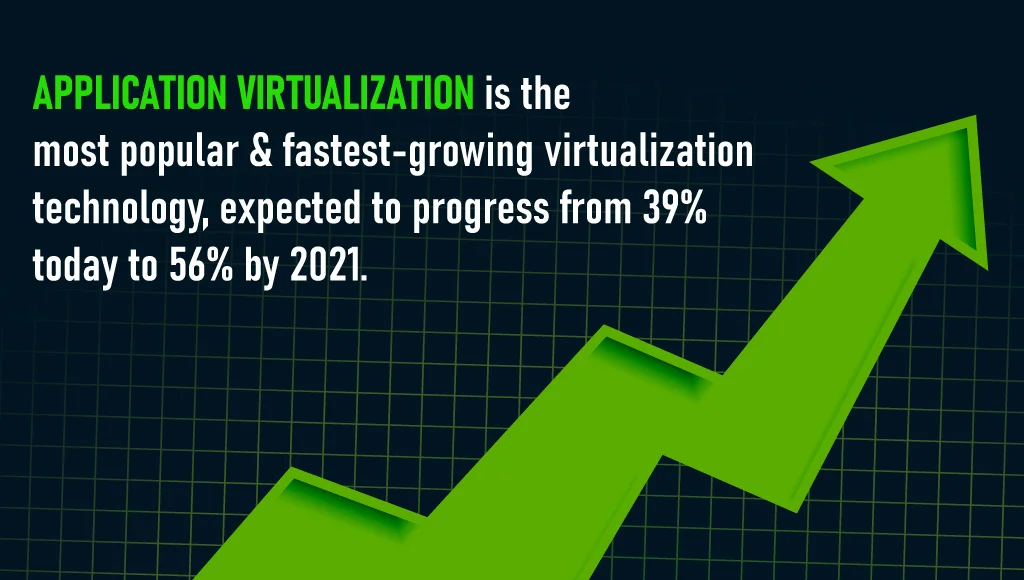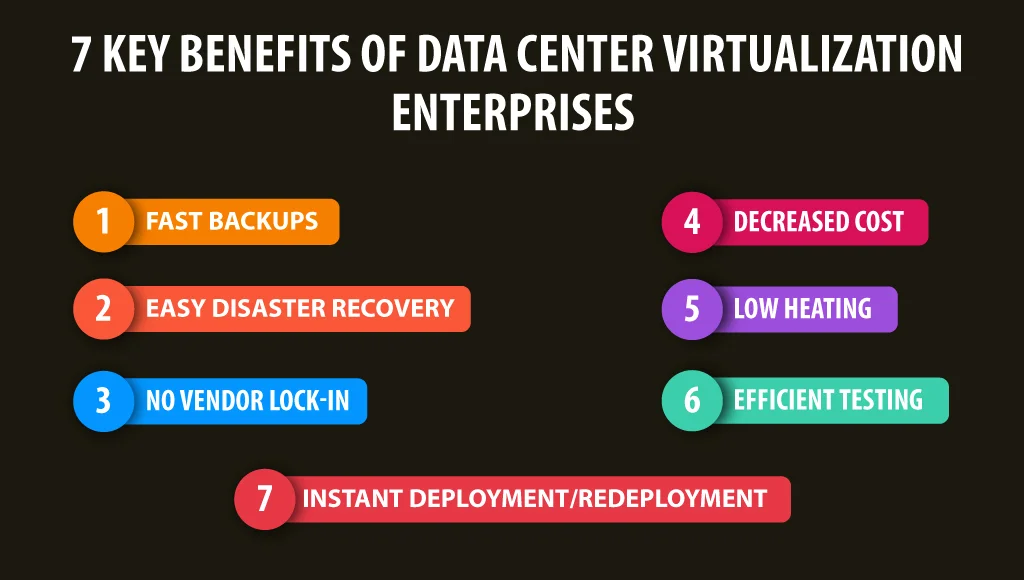It depends on the server capacity and application resource requirements for the virtual server. The greater the capacity of equipment and the lower the consumption, the greater the number of virtual machines that can run.
Blog
Top 7 Benefits Of Using Virtualization Technology For Businesses
Introduction- The World is Adopting Virtualization Technology
In the earlier times, applications and software used to run on physical servers sitting mostly idle in the server rooms. However, today server virtualization has extraordinarily advanced IT efficiency adopted as a standard industry practice. It has come into the picture with further added benefits like higher workload portability, application isolation, improved scalability, and higher availability options. Most of the enterprises are looking for obtaining similar merits of incorporating networks, storage, applications, desktops, and many more. There are some points regarding the adoption of virtualization technology, worth to be noted, as per a recent survey:
- Virtual environments are shifting to the cloud. Businesses are considering moving their entire server virtualization system to the cloud in the coming two years.
- Virtualization goes beyond servers, so in the upcoming years, double-digit growth is anticipated in the use of the network, desktop, storage, and data virtualization.
- Server Hypervisor Technology is believed to act as a commodity for most of the IT decision-makers.
- A large percentage of enterprises are planning to use software-defined storage solutions instead of shared storage arrays.
What is Virtualization Services?
Virtualization is not just about virtual machines (VMs) or their associated hypervisors and OS implementations, but it’s way beyond that. Virtualization is the process of running a virtual instance of a computer within a layer that is abstracted from the actual hardware. The applications appear to be running on their dedicated machine, but actually, they run on top of the virtualized machine. They offer the corresponding benefits of scalability, reliability, cost, flexibility, and overall performance and capability.
Virtualization offers tons of reasons for people to use in computing. Desktop users use it to run the applications meant for a different OS without the need to reboot the computer systems or to switch the systems. Virtualization provides the server administrators a way to segment a large system into smaller sub-systems. The server can be put to use more efficiently to meet the different application needs for different users. Virtualization is all about hypervisors and virtual machines. A hypervisor is a program built for creating and running virtual machines. On the other hand, a virtual machine is the emulated equivalent of a system running on top of another system.
Statistics of Virtualization Used by Businesses
Server Virtualization is currently in use by approximately 92% of the businesses out there. Well, there few emerging forms of virtualization technologies. The most common one is the storage virtualization adopted by around 40% of the businesses worldwide. It is followed by application virtualization at an adoption rate of 39% and virtual desktop infrastructure (VDI) at 32%. There are two more types, namely data virtualization and network virtualization, bagging an adoption rate of 30%. It is predicted that application and storage virtualization will be a part of half of the businesses by 2021.

Application Virtualization is the most popular and fastest-growing virtualization technology, expected to progress from 39% today to 56% by 2021. The adoption of virtualization technologies by businesses and enterprises is anticipated to grow significantly by 2021. The estimates for the market size for the global virtualization software market today are between 14 and 16 billion US dollars. The forecasts predict the virtualization market to further flourish over the next few years reaching revenue between 26 and 34 billion US dollars.
How virtualization allows enterprises to maximize output?
More than 80% of the data center workloads have been virtualized to date. Virtualization improves efficiency, boost performance, free up resources, cut costs and enhance security. Here are some of the points how virtualization enables enterprises to produce maximum throughput:
- Server consolidation is made quite simple along with streamlined management. Costs can be decreased to a great extent and vendor lock-in remains mitigated.
- Enterprises are experiencing enhanced workload performance, improved application availability, and also cost-effective scalability.
- Virtualization speeds up resource delivery through centralized and automated resource management. You can reduce the cost of a non-production environment through virtualization tools.
- Virtualization offers increased visibility and speed with which you can create a security-focused, non-destructible environment to reduce certain risks.
- Virtualizing the workstation environments can assist you with the simplification of administration, regained control, and access to data.
- Virtualization for enterprises deliver a seamless and standard quality user experience and improvised control and security.
7 Key Benefits of Data Center Virtualization
Enterprises are constantly gathering efforts to attain maximum optimization in their IT infrastructure systems. Organizations are considering optimized solutions for their data centers and their solution lies in establishing virtualized data centers.
1. Fast Backups:
You can take backups of the virtual machines and virtual servers. The machines can be drifted between each other and redeployed quickly, which includes capturing automatic snapshots throughout the day.
2. Easy Disaster Recovery:
Virtualized environment makes the disaster recovery process very simple. The virtual machines, taking regular snapshots and providing up-to-date data can be easily backed up and recovered.
3. Instant Deployment/Redeployment:
A virtualized data center makes the process of server redeployment relatively simple and quick, in case your physical server has crashed. Veeam is one of the virtual backup tools that help with facilitating the process to few minutes.

4. Decreased Cost:
The reduced number of hardware eventually reduce the costs of purchasing and maintaining them. Virtual servers can be easily maintained in comparison to physical servers.
5. Low Heating:
The more the number of physical hardware servers, the more heated the data centers tend to become. An efficient way is to reduce the number of servers used for data management to curtail overheating servers.
6. Efficient Testing:
Testing becomes less tiresome with a virtualized environment. You can access the previous snapshot and resume your work, even if you make a major mistake.
7. No Vendor Lock-In:
No kind of dependency is involved on any specific vendor, platform, or server type. Virtualized setting does not involve any kind of hardware or software. Virtualization Services assists in green technology and reduces the headache encountered by administrators while dealing with physical servers.
Also Read: 5 Applications of IoT in Making Agriculture Industry Smarter
Previous Blog Post.
Conclusion
A virtual model implemented correctly offers your enterprise a host of benefits which include expanded access to a wide variety of applications and increased efficiency. The advantages of the virtualization world not only prove practical in supporting and maintaining the organization’s operational activities but can also streamline their operational costs. Moreover, data center virtualization refers to creating several logical instances of software or hardware on an individual physical hardware resource. This mechanism allows maximum and optimum utilization of hardware resources for each through dynamic resource allocation.
Consult SNDK Corp for benefiting your business with Virtualization Services & Solutions.
FAQs
VMware is the dominating and the most frequently used tool accounting for controlling over 55 percent of virtual servers. IBM is the second most popular tool after VMware capturing 9.8 percent of the market.
